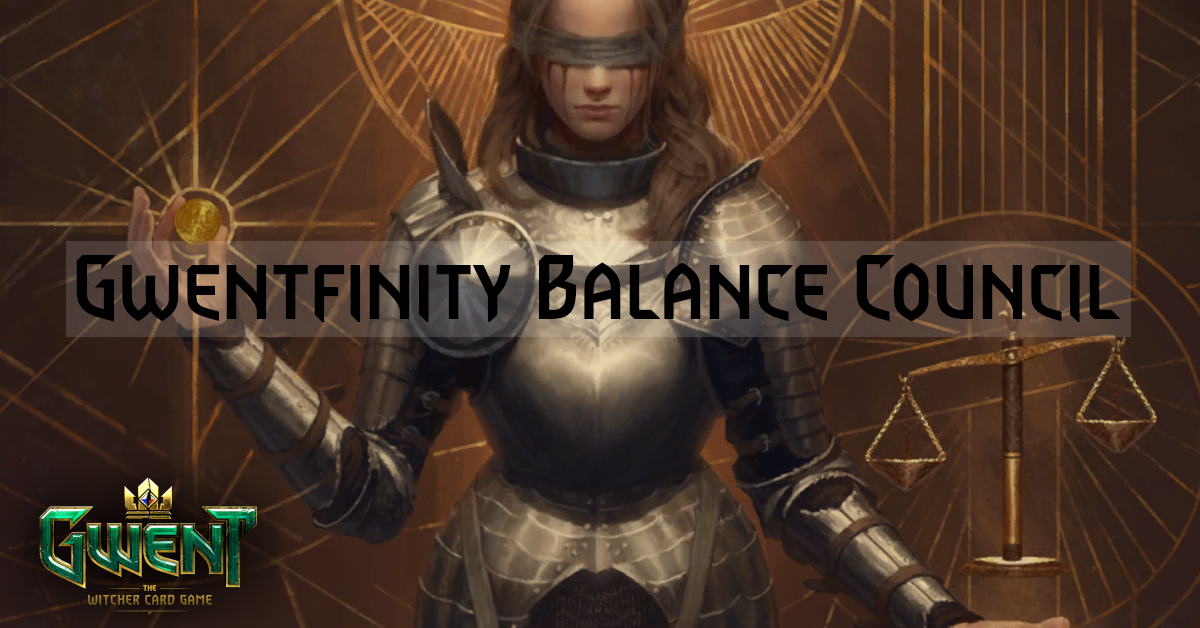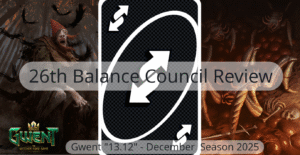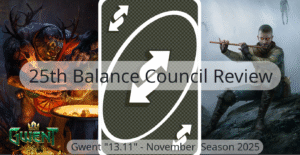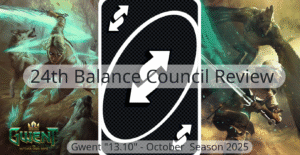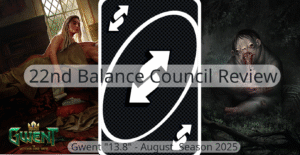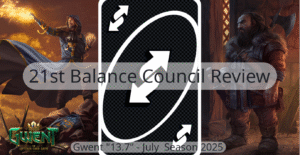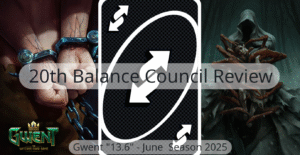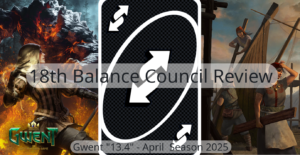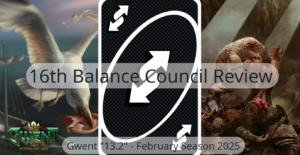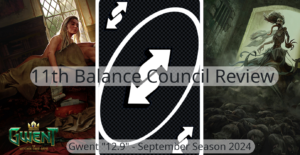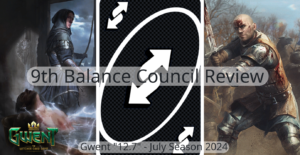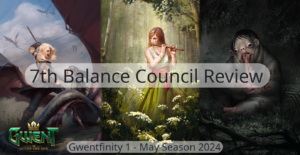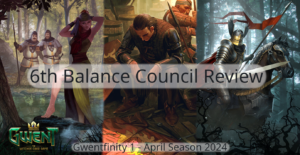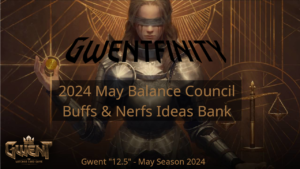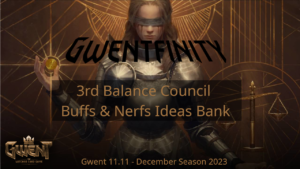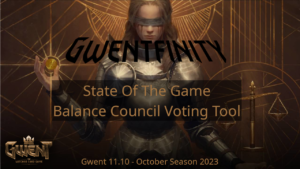The Laws Of Gwent Balance Council (BC)
The rules of Balance Council in Gwent: The Witcher Card Game are described in the official FAQ. The practice of Gwent Balance Council shown that following points are also true and important to know (updated April 2025):
- Idealistic vision of independent voters spontanously coming together to solutions best for the community is both unreal and untrue:
- There is no coordination for such votes. For example if a deck deserves a nerf, but there are 5 popular ways to do it, then very often all 5 nerfs would get through and result in an overnerf.
- Creative and unobvious changes cannot pass without broad communication. Picking a very smart change wouldn’t bring any effect unless you are vocal about it in the Gwent community, trying to get as much support as possible. People would never spontanously come to conclusions same as an independent voter in big enough number unless there is strong sentiment for a given card.
- What goes through most often for independent voters are reverts of last season nerfs (=buffs) to popular decks and nerfs of the most popular cards, especially if those convey negative emotions.
- Russian/CIS and Chinese community are most represented in Gwent (check out Nations of Gwentfinity article) and would always have the highest influence on Balance Council results. Balance Coalitions formed by different communities proven to be effective only for really big communities and really influential players, able to impose strong alignment. Even most represented nations, like China, proven not effective if divided. By Balance Coalition we mean aligning votes according to one template, often after poll and discussion phase. For example (April 2025):
- Russian/CIS Coalitions – MetallicDanny, ACP (Active CIS Players)
- Chinese at first voted independently, but soon formed a coalition when seen how little impact disaligned votes give. First instances of CN coalition were great impact. CN Coalitions though aren’t stable – they are established and dissolved due to internal disagreements and competition between more democratic and authoritative models. The most recent one: Chinese Coalition
- The rest of the world could hope to get votes through only by strong alignment. Around 30%, which is 3 changes per bracket is a real target. That being said, of course communities don’t have to act nationwise – many voters just pick favorites from various coalitions. Kerpeten&Dauren (also CIS), Shinmiri&Lerio.
- Balance Coalitions are effectively reducing democratic factor – individual voter means less than in the case of closer vote distributions – but enable better coordination and (unless influencers are misguided) are good for the game.
- High coordination requires communication between influential groups; otherwise it is very likely to overnerf or overbuff archetypes if two groups share same approach.
Which Cards To Buff?
- There are three different groups of cards and approaches when it comes to buffs in the Balance Council:
- Buffing the weakest unplayed cards. This approach is generally good for the long-term balance, but doesn’t bring any meta shifts; the weakest cards need a couple of coordinated buffs to become meaningful. What is important when following this approach is choosing cards with interesting effects, which indeed may bring something new to Gwent gameplay and mathematics. Picking up a card just because it ‘looks too bad’ or ‘deserves justice’ is not a fruitful approach.
- Buffing completely unplayed cards, which instantly become considerable. That’s the middleground approach, good both for the long and short term. The number of such cards is generally limited. Also before picking such a card you need to have good recognition to make sure: 1) that the card is indeed unplayed because of being underpowered, not just because of ladder fashion, 2) the card wouldn’t become overpowered/unhealthy, which is important because greedy engines power buffs are most common in this group. In Gwent Balance records examples of this approach are: Mutant +1p, Whisperer of Dol Blathanna +1p, Griffin Adept +1…
- Buffing played cards in factions/archetypes regarded as underperforming/unpopular – this approach gives the most instant impact, but when not used with caution tends to result in powercreep and immediate reverts, which is bad in the long term. First we need to make sure the given archetype is at Tier 3 or lower power level indeed. Sometimes archetypes are commonly regarded as ‘bad’ just because of not being tried, while in fact are top dogs – in 2024 an example would be Enemy Boost NG until picked up by Kerpeten. Then we need to choose a card which doesn’t support any stronger decks yet and wouldn’t after the buff either. An example of well done change of this type is +1 power buff to Alumni.
- Another approach is impact chase. We want to get immediate meta shake and instead of balance considerations we simply choose changes which would boost desired archetype most. The target decks are from high Tier 2 so they are supposed to become Tier 1 after buff and get guaranteed popularity. This approach is very bad for the game. Not only it leads to powercreep with best decks going further and further from Tier 3 / low Tier 2, resulting in low diversity. Also almost every card buffed this way would be a natural object for an immediate revert in the next patch. We end up walking in circles.
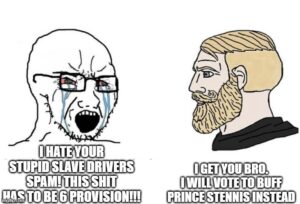
Which cards to nerf?
The number of nerf candidates is always smaller than the number of buff candidates. Therefore nerfs are usually better focused than buffs in the independent community (but for reverts).
- Following nerf approaches are common:
- Nerfing most provision efficient cards from strongest meta decks – natural and necessary approach; strongest deck should receive nerfs to keep the meta fresh. What could go wrong here is overnerf when voters pick too many cards from netdeck. To avoid it, best thing to do is checking influencers suggestions before casting final votes. Remove votes which will contribute to overnerf if taken along with their suggestions.
- Nerfing cards from most popular deck (no matter power) – with the purpose of making ladder more diverse. I’m against this approach – it is basically making community favorite deck weaker for no reason. Revert in the next patch is extremely likely. Popularity should not be a crtierion, only balance.
- Nerfing card with unhealthy / binary character. Plausible approach, some cards deserve nerf to disincentivize them being played even when balanced on average. The tricky part is defining what card is indeed unhealthy and what just hated. Defenders to 10-cost campaign is example of reasonable approach, while Reaver Hunters to 1 power – definitely not.
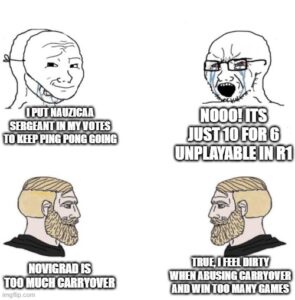
Lerio & Shinmiri Balance Coalition
June 2024 is the first time we joined together and aligned votes with the legendary Gwent streamer Shinmiri. Since July 2024 during the month we release a poll (on Reddit, example from July) where we measure community sentiment towards various nerfs / buffs ideas. We don’t follow the order of top votes strictly, but we avoid unpopular picks as unlikely to go through.
2024 | June | July | August | September | October | November | December
2025 | January | February | March
The Record Of The Past Balance Patches (BC History)
- “BC Vintage” spreadsheet by A_Reveur – the past Balance Council results along with number of votes order data mined for game files, attribution of votes to balance coalitions and useful links.

